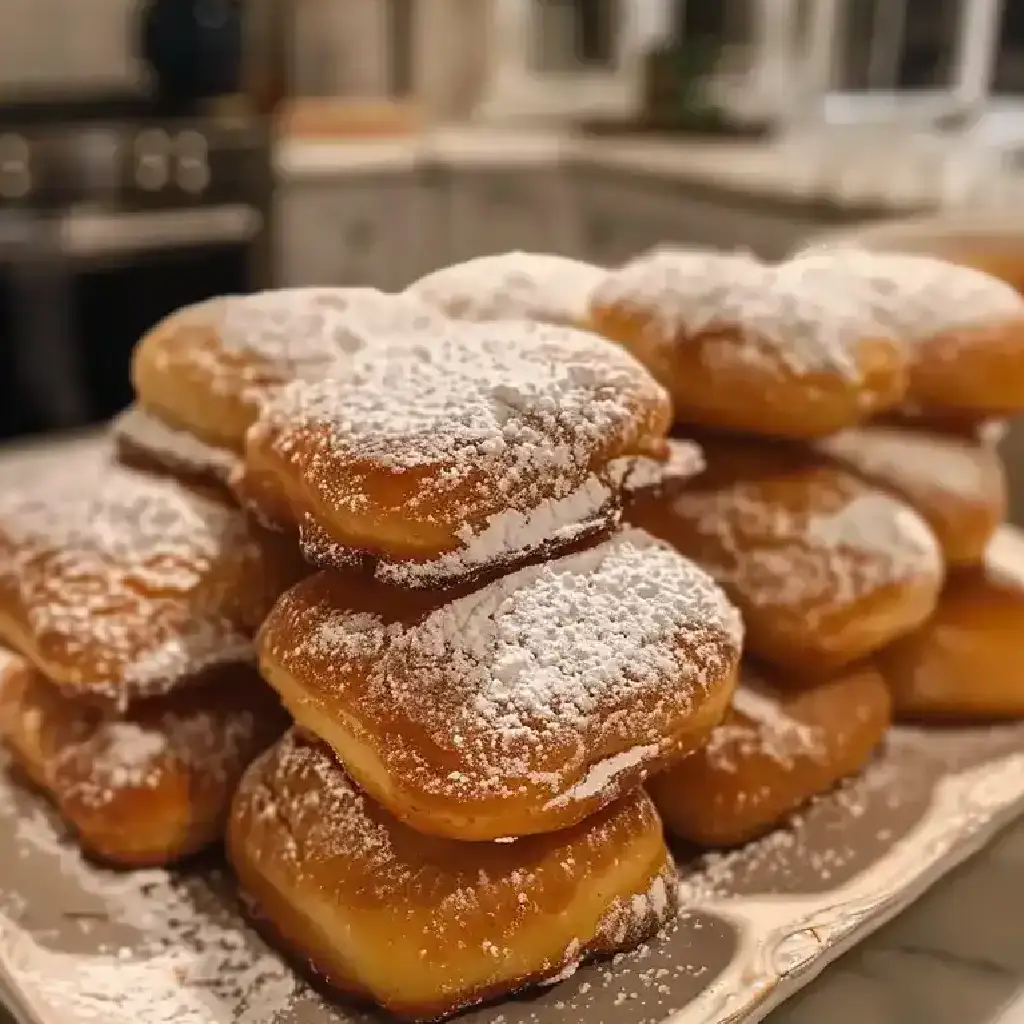Introduction:
Vanilla French Beignets are a delightful, light, and airy pastry that’s deep-fried to golden perfection, dusted with powdered sugar, and often served hot. They are a beloved treat that can be enjoyed at any time of day, whether for breakfast, a snack, or dessert. The French version of beignets is particularly well-known in New Orleans, where it is famously served at Café du Monde, though the pastry’s roots reach much farther back in French history. In this recipe, we focus on adding a subtle vanilla flavor to the dough, giving it a smooth, sweet richness that complements the light, fluffy texture.
The History of Beignets:
The term “beignet” comes from the French word for “fritter,” and these pastries have been a part of French culinary tradition for centuries. Beignets are thought to have been introduced to France by the Romans, who had a tradition of frying dough and serving it with honey. In the 18th century, beignets became a popular treat in France, particularly in the city of Paris.
When French settlers and immigrants arrived in Louisiana in the 18th century, they brought beignets with them. Over time, these pastries became a beloved part of New Orleans culture, with the city becoming famous for its deep-fried doughnuts. The iconic Café du Monde, which opened in 1862, serves beignets with powdered sugar, and they are still enjoyed by locals and tourists alike.
Ingredients Breakdown:
- All-Purpose Flour: Forms the base of the dough, providing structure.
- Baking Powder: Helps the dough rise and become light and fluffy.
- Granulated Sugar: Adds sweetness to the dough.
- Salt: Balances the sweetness and enhances the flavor.
- Eggs: Bind the ingredients together and provide structure to the dough.
- Milk: Hydrates the dough and helps create a soft texture.
- Vanilla Extract: Infuses the dough with a sweet and aromatic flavor.
- Butter: Adds richness and moisture to the dough.
- Vegetable Oil: For frying the beignets, creating a crispy exterior.
- Powdered Sugar: Used for dusting the beignets, giving them that classic New Orleans look.
Step-by-Step Recipe:
Ingredients:
- 2 cups all-purpose flour
- 1 tablespoon baking powder
- 2 tablespoons granulated sugar
- 1/4 teaspoon salt
- 2 large eggs
- 1/2 cup milk
- 1 teaspoon vanilla extract
- 4 tablespoons unsalted butter, melted
- Vegetable oil (for frying)
- Powdered sugar (for dusting)
Instructions:
- Prepare the Dough:
- In a large bowl, whisk together the flour, baking powder, sugar, and salt.
- In a separate bowl, whisk the eggs, milk, vanilla extract, and melted butter until well combined.
- Gradually add the wet ingredients to the dry ingredients, stirring until a dough forms. The dough should be soft and slightly sticky but workable.
- Roll the Dough:
- Turn the dough out onto a lightly floured surface and roll it out to about 1/4-inch thickness.
- Using a knife or pastry cutter, cut the dough into squares or rectangles, approximately 2-3 inches in size.
- Heat the Oil:
- In a large pot or deep fryer, heat about 2 inches of vegetable oil over medium heat until it reaches 350°F (175°C). You can check the temperature with a thermometer or drop a small piece of dough into the oil—if it sizzles and rises to the surface quickly, the oil is ready.
- Fry the Beignets:
- Carefully lower the dough pieces into the hot oil, frying in batches to avoid overcrowding. Fry the beignets for 2-3 minutes on each side, or until golden brown and puffed up.
- Use a slotted spoon to remove the beignets from the oil and place them on a paper towel-lined plate to drain excess oil.
- Serve:
- While the beignets are still warm, generously dust them with powdered sugar. Serve immediately, and enjoy the delicious, warm, fluffy treat!
Tips for the Perfect Beignets:
- Oil Temperature: Ensure the oil is at the right temperature (350°F/175°C). If it’s too hot, the beignets will brown too quickly and remain raw inside; if it’s too cold, they will absorb excess oil and become greasy.
- Fluffiness: Do not overwork the dough. Over-kneading can result in denser beignets.
- Size Consistency: Try to keep the beignet pieces uniform in size for even cooking.
- Dusting: Be generous with powdered sugar, but if you want a less sugary version, you can dust lightly or skip it altogether.
Variations and Customizations:
- Flavor Variations: Try adding other flavor extracts, like almond or citrus, to change up the flavor profile.
- Chocolate Chips: Mix in mini chocolate chips or chopped chocolate for a sweet twist.
- Stuffed Beignets: For an extra treat, stuff the beignets with a filling like Nutella, fruit jam, or pastry cream before frying.
- Savory Beignets: Skip the sugar and vanilla, and add herbs and cheese for a savory version. These are perfect as a snack or appetizer.
Health Considerations and Nutritional Value:
Beignets are a delicious, but indulgent, treat. They are typically deep-fried, which adds a significant amount of calories and fat. To make them healthier:
- Reduce Oil Absorption: Use a deep fryer with temperature control to minimize excess oil absorption.
- Baking Instead of Frying: For a lighter version, try baking the beignets at a high temperature instead of frying.
- Reduce Sugar: You can reduce the amount of sugar in the dough or skip the powdered sugar topping to lower the calorie count.
Nutritional Value (per serving, 1 beignet):
- Calories: ~200-250
- Carbohydrates: 25g
- Fat: 10g
- Protein: 2g
- Sugar: 8g
(Note: Nutritional values will vary depending on portion size and preparation methods.)
FAQ:
Q: Can I make the dough ahead of time?
A: Yes, you can refrigerate the dough for up to 24 hours before rolling and frying. Just be sure to let it come to room temperature before rolling it out.
Q: How do I store leftover beignets?
A: Beignets are best enjoyed fresh. However, you can store them in an airtight container for up to 2 days. To reheat, place them in the oven for a few minutes or heat them in a pan.
Q: Can I freeze beignets?
A: Yes, you can freeze the un-fried beignets. Lay them out on a baking sheet in a single layer and freeze until solid. Once frozen, transfer them to a freezer bag. Fry from frozen, adding an extra minute or two to the cooking time.
Q: Can I use a different type of flour?
A: All-purpose flour is recommended for the best texture. However, you could experiment with gluten-free flour blends, though the texture may differ slightly.

Vanilla French Beignets
Ingredients
Method
- Prepare the Dry Ingredients: In a large bowl, mix together 2 ½ cups of all-purpose flour, ¼ cup of granulated sugar, 2 teaspoons of active dry yeast, and ½ teaspoon of salt. Stir thoroughly to evenly distribute the yeast and sugar within the flour.
- Mix the Wet Ingredients: In another bowl, whisk together 1 cup of warm milk (around 110°F), 1 tablespoon of melted unsalted butter, and 1 tablespoon of pure vanilla extract. Make sure the mixture is warm to the touch, but not hot, to activate the yeast without damaging it.
- Combine the Wet and Dry Ingredients: Gradually pour the wet mixture into the dry ingredients while stirring with a wooden spoon. Continue mixing until a dough starts to form and all ingredients are well incorporated.
- Knead the Dough: Place the dough onto a lightly floured surface and knead for 8-10 minutes, or until it becomes smooth and elastic. If the dough feels too sticky, add a little more flour as needed.
- Let the Dough Rise: Place the kneaded dough into a greased bowl, turning it once to coat all sides with oil. Cover the bowl with a clean cloth and let it rise in a warm, draft-free place for about 1.5 hours, or until it has doubled in size.
- Shape the Beignets: Once the dough has risen, punch it down and roll it out on a floured surface to a thickness of about ¼ inch. Cut the dough into 2×2 inch squares using a sharp knife or pizza cutter.
- Heat the Oil: Pour about 2 inches of vegetable oil into a deep fryer or large pot. Heat the oil to 360°F, using a thermometer to ensure the correct temperature.
- Fry the Beignets: Fry the beignets in batches, making sure not to overcrowd the pot. Cook for 1 to 2 minutes on each side, or until they are puffed up and golden brown. Use a slotted spoon to remove them from the oil and place them on paper towels to drain.
- Serve: Dust the freshly fried beignets with powdered sugar and serve them while still hot.
- Cooling (Optional): If you’re not serving them immediately, let the beignets cool slightly on a wire rack to help them maintain their crispness.
